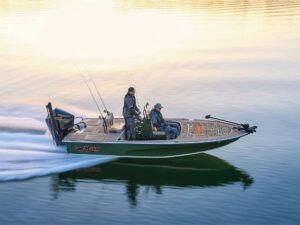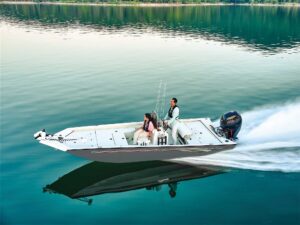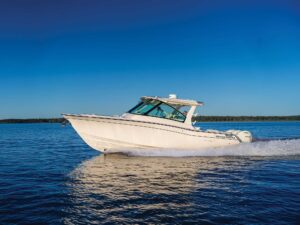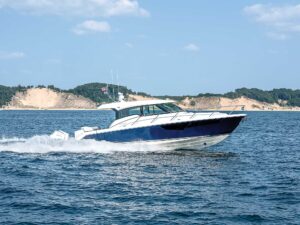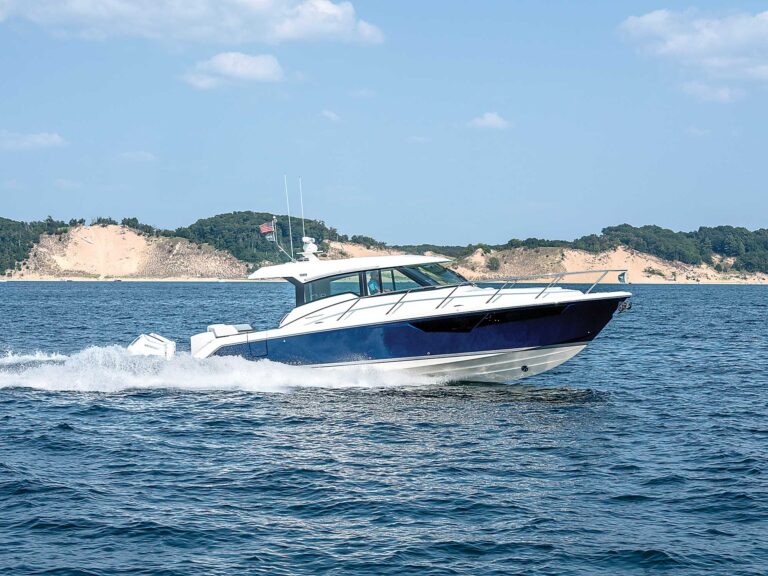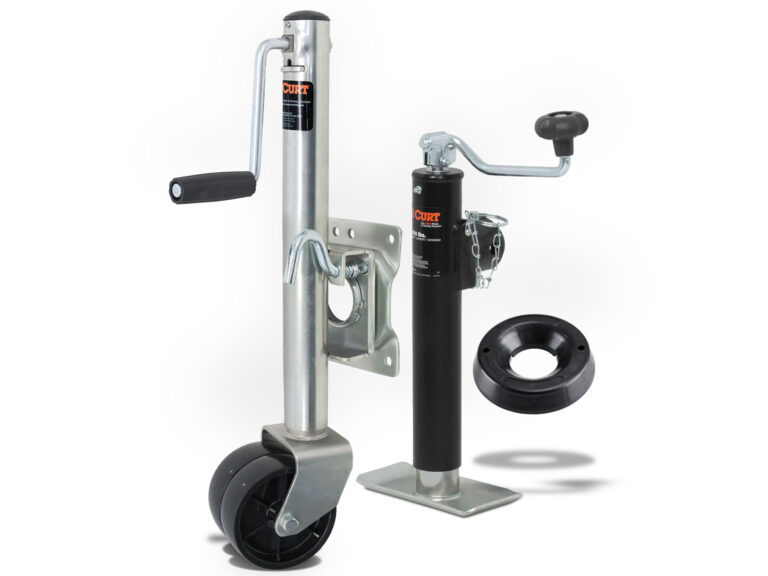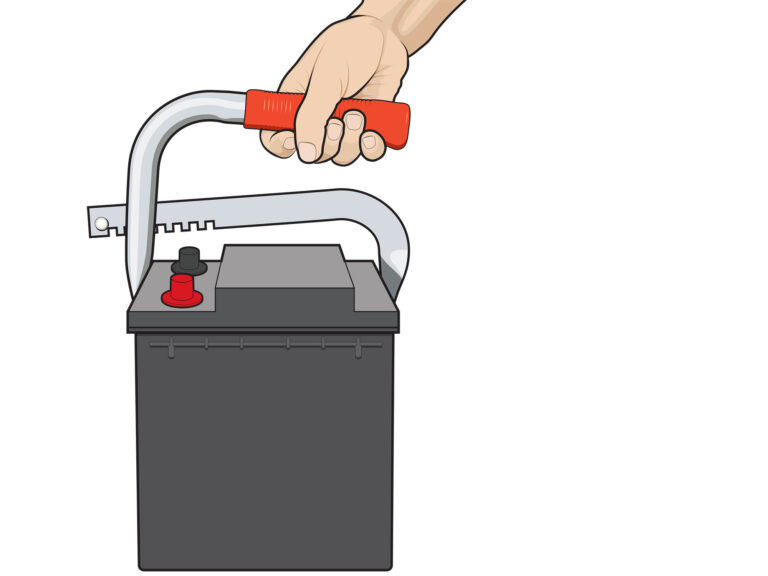Several years ago, Boston Whaler tooled its 320 outrage hull with a sleek, hydrodynamic profile, sharp entry and hard chines. It gave it a strong, deep deadrise too, and the resulting hull rode soft and true. With a proven bottom like that, when it came time to bring the boat up to date, all of Whaler’s engineers focused on getting more boat from the same footprint. The goal was to do that and retain the unsinkable solid feel for which Whalers are revered. In short, the new 320 outrage would have to be roomier, more comfortable, more fishable and easier to maintain than its predecessor. To prove it, I didn’t just sea-trial the 320; I also fished it with five other anglers in conditions so crummy that few other boaters ventured from Ponce Inlet, Florida, near the Whaler factory that day.
Outboards are kings among fish boats: they get power out of the cockpit and tilt up at the dock to save the gear case from corrosion. But that tilting feature in most motors is the culprit for gobbling cockpit space. Keeping them clear of the European-style transom — really a bulkhead forward of the transom — requires pushing that bulkhead forward into the cockpit to accommodate the tilt. Mercury Verados tilt differently, though, lifting from the back instead of pivoting forward. These motors let Whaler put the transom/bulkhead aft four inches. Plus, construction techniques save the company about four inches on the transom’s thickness, adding a total of eight inches to the cockpit. That’s a significant piece of real estate for six anglers.
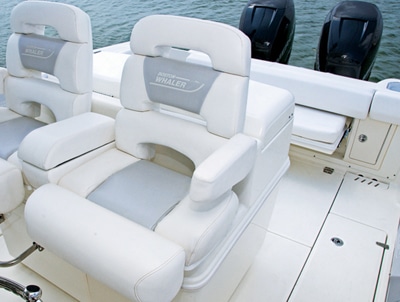
To make the best of it, Whaler enhanced the leaning post to include either a fishing station with tackle center and livewell or its “Summer Kitchen Leaning Post,” complete with grill and sink. Our test boat boasted the fishing station, which our mate used for rigging baits and rods while we powered out to the fishing grounds through the bumpy inlet. Seas bested four feet, but we decided to drop baits on the buoys while our guide held us off by massaging the super-slick DTS (digital throttle and shift) control box that Mercury includes with its all-digital SmartCraft control and information system. Power steering, also a benefit of Verado, further eased control. (If you wanted those whistles and bells from a competing set of outboards, you’d need to be sure to upgrade to Teleflex Power Assist steering with Yamaha, Evinrude or Suzuki power. Honda doesn’t offer digital throttle and shift, but its motors can be equipped with power steering.) Forward visibility from the helm was enhanced thanks to the downward slant on the helm station, allowing me to see the foredeck, passengers and the water forward.
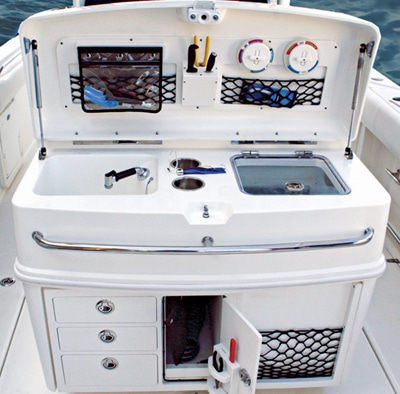
Moving out to the reef, it was easy to find comfort behind the helm thanks to deep seats and armrests in the leaning post. seats are fixed with bolsters, and a knee-high and thigh-high step in the helm station give support for tall or short crew members. We stayed tucked behind the glass enclosed helm and out of the spray while moving, but I see the practicality of the seats that easily flick out of the coamings to port and starboard of the helm station. In either, I could sit facing aft to watch the rods while trolling and maintain eye contact with the helmsman and crew. In hot weather this entire area can be ventilated by opening the glass near the hardtop and turning on misters that draw water from the freshwater tank.
Whaler made passage through the boat easier by integrating streamlined hardtop supports into the console and securing them to the deck as well, instead of running pipes to the deck around the console. Alternatively, Regulator mounts T-top supports to the side of the console to increase walk-by space and decrease the chance deck fasteners could wear into fuel tanks. The Regulator 32 is available with twin Yamaha 350’s ($197,615).
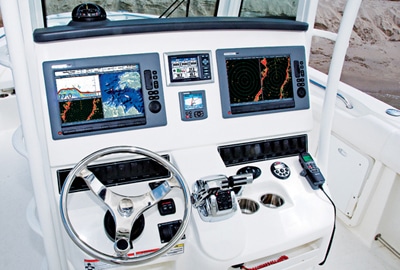
Once forward on the 320 outrage, it’s apparent that Whaler targets equally customers impressed by fishability and by cruising comfort. Forward fish lockers can double as lounge seats, and forward seating on the helm station can create a conversation pit or sunning area. On boats strictly targeting anglers, such as the Contender 31T ($192,000 with twin 300 Yamahas), owners lean toward the flat, open deck that better accommodates bottom fishing. We noted in our prototype tester that the seat cushion on the console’s forward seat was mismatched to the narrower base and rubbed our shins as we passed, but we’ve been assured Whaler has corrected this in subsequent builds. Under the fore seats, fish lockers drain to a central coffin box, which is in turn emptied by a macerator pump.
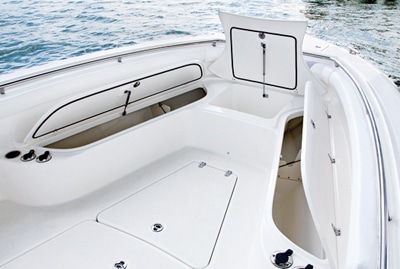
Access to fuel tanks — yep, twin tanks feed their respective engines — is easy under the hatch, as is access to pumps and other hardware below. Couple the ease of below-deck maintenance with the bulletproof hardware, and we’d expect the boat to provide lots more fun between servicing hours than the average craft.
The fishing cockpit is expanded to enhance fish-fighting space, and some of the space was used to add improvements to the helm station and leaning post. Our leaning post was equipped with a livewell and bait station. Many Whaler customers would opt for the “summer Kitchen,” and, considering the social nature of boaters, we could see why.
For more information be sure to check out the 320 Outrage’s Virtual Test Drive.
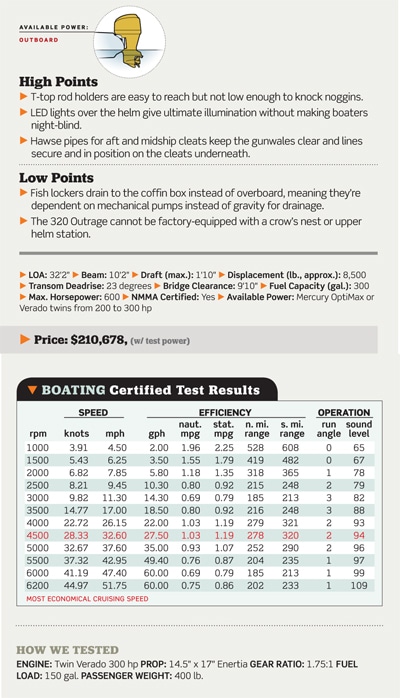
Boston Whaler – Edgewater, Florida; 877-294-5645; bostonwhaler.com

